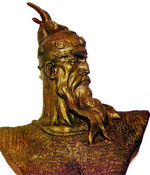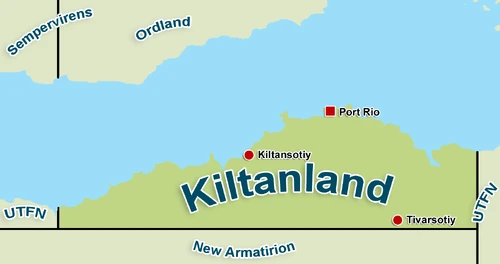| Tribal Theocracy of Kiltanland Daoslenad iv Kiltans | |
|---|---|
| Conventional short name: | |
| Local: | Kiltanlenad |
| Ingallish: | Kiltanland |
| Data codes: | KI, KIL |

| |
| Languages: | |
| Official: | Kiltanian |
| Others: | Ingallish |
| Cities: | |
| Capital: | Port Rio |
| Other: | Kiltansotiy, Trivarsotiy |
| Government type: | Clan-based tribal theocracy, elective monarchy |
| Chiefest of the Kiltans: | Jay iv Griffin |
| Population: | 3.606.952 (298 est.) |
| Established: | 17th of July, 298 |
The Tribal Theocracy of Kiltanland (Kiltanian: Daoslenad iv Kiltans), usually known as Kiltanland or Kiltanlenad, is a country in Nuarmia.
History[]

Griffin of Old, traditional patriarch of the Kiltan clans.
The semi-mythical, semi-historical king Griffin of Old is considered the traditional father of the Kiltan nation.
For several centuries, the Kiltan clans inhabited the extreme north of Nuarmia. By circa 140BP, their neighbours from across the sea, Ordland, established colonies on the region, displacing most of the Kiltans, which then began a long diaspora. The details of this expulsion were told in tales passed down orally from generation to generation. During their exile, the Kiltans developed into a seafaring culture, often finding a living as fishermen and coastal traders. There was also a tradition of Kiltan sailors and officers in various of the navies in the region.
Although scattered across Nuarmia, mostly finding refugee amongst other related clan-based societies - such as the peoples of Caledon - their numbers grew, the Kiltans banding more closely to one another and to their ancient beliefs. However, this cultural cohesion at times led to the Kiltans being persecuted in their host countries.
Due to these persecutions, sometimes quite violent, Jay iv Griffin, chief of the Kiltan clans since 292, started a political movement for seeking a new homeland for the Kiltans. Although some clans proposed a settlement in lands far away such as Whiland and Ptica, eventually the clans pushing for a return to the traditional Kiltan homeland in Nuarmia won the case.
In 297AP, the fascist State of Rio was proclaimed, with the city of Port Rio as its capital. In 298, after a short war against Armatirion, known as Operation Cutlass, Rio colapsed under the pressure from several resistance movements. On the 17th of July, with support from Cruisana, the United Nations of Vexillium accepted Jay iv Griffin's appeal and proclaimed the independence of Kiltanland. Most of the Kiltans then returned to their homaland after a long exile.
Government[]
Kiltanland is a clan-based tribal theocracy. The Council of Chieftains is composed of the chiefs from each clan. It functions as the primary legislative and judicial body of the nation. The eldest among the chieftains form a special judicial council to which appeals may be made.
The head of Kiltan government, known as "The Chiefest of the Kiltans," is chosen from among the Council of Chieftains and rules for life. He is the political, cultural and spiritual leader of the Kiltan people. The present Chiefest of the Kiltans, Jay iv Griffin, has ruled since his ascent to the throne in 292, while the Kiltans were still in exile.
Local government is left for decision of the families and clans living in each area.
The teachings contained in the ancient sacred writings known as the Daosvirid provide the moral authority for Kiltan government as well as all facets of Kiltan life.
There are no political parties in Kiltanland.
Geography[]
Kiltanland is located in the northern part of the continent of Nuarmia, on the shores of the Rian Strait, bordering the United Territories of Fiarria and Nuarmia (UTFN) and the colony of New Armatirion. Important cities in the country are the capital Port Rio, Kiltansotiy and Trivarsotiy. Over 40% of the population resides within 100km of Port Rio.
The tallest peak in the country is known as Mount TaGraef, at 3.750m.
Economy[]

The traditional Kiltan spinning globe - this one displaying the international borders as they were in 298.
Kiltanland has a small economy. Thanks to its location, Kiltanland is a traditional tropical tourist destination. Tourism makes up a good part of the local economy. Agriculture, once the most important sector, is being dwarfed by industry, which accounts for 38% of the GDP, 80% of the exports and employs 26% of the labor force. Important industries include food, textiles, petroleum, pharmaceuticals, jewelry, glass and crystals.
Exports of traditional handicraft and art are also important. One traditional Kiltan craft are its so-called "perpetual motion globes", small spinning Vexillium globes kept afloat a few milimeters from its base thanks to magnetism. Other famous local artforms are the sculptures known as the "dream books" and "dream castles".
Unemployment remains a serious problem, however, and job creation is the main focus of government policy. To ease unemployment, Jay iv Griffin personally courts foreign investors.
The country also has major reserves of zinc, lead, natural gas, petroleum, barite, copper, gypsum, limestone, dolomite, peat and silver.
Kiltanland also has an ideal climate for growth of several illegal drug crops. This and the fact that the country acts as a transshipment point for and consumer of unrefined hallucinogens and synthetic drugs are a point of constant friction with its neighbours.
The currency of Kiltanland is the dileri (D).
Demographics[]
Kiltanland has a total population of 3.606.952 (298 estimative), with 60% being of the Kiltan ethnic group. Circa 22% are Kiltanscots - that is, descendents from both Kiltans and the peoples from Caledon - while other 15% claim Ordlandic descent.
The foundation of Kiltan society is the family. Each Kiltan citizen bears the surname of the family to which he or she belongs. Families in turn belong to a clan.
Roughly the entire population speaks Kiltanian - a member of the "Al Diredi" language family - as its only language. There's a minority of 5% of Ingallish speakers. Cruisanism is the religion of 34% of the population - most of the affiliated to the various denominations of Kiltanian Orthodoxy. There are also groups of adherents of the Sun and Moon Cult of Ordland and the local Globalian religion. Roughly 20% are atheists.
Symbols[]

National flag of Kiltanland.
The most important Kiltan symbol is the national flag. The color blue is an historical symbol of the seafaring Kiltans - in their long exile, it was told that one day, the rivers and seas would lead the Kiltans back to their homeland. The blue on the flag also forms a traditional Kiltan Cross. At the center of the flag is the Kiltan compass, the symbol of the Kiltans' maritime lifestyle.
The official motto of Kiltanland is Iyr Pilesa Onta Pilenat - Kiltanian for "Our Place in the World". The national anthem is known as Iv Kiltanlenad O Diraem - "Of Kiltanland I Dream".
Military[]
The defense forces of Kiltanland are the Army (includes Naval Service and Air Corps) and the National Police (Gyerid Paipila). Military expenditure ammounts to 1.3% of the country's GDP.
